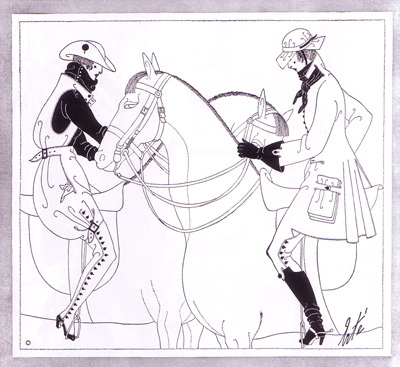Remembrance of Design Past: Erté 
When Romain de Tirtoff Erté was asked to put together a few lines about himself for the March 1919 issue of Harper’s Bazar, he was hesitant to reflect on his body of work at that point in his life: ‘Those things told by an old master might interest the public, but I prefer to give your readers my work, for at my age my art, which is my life, is the only language through which I speak with the world.’ (Stella Blum. Fashion Drawings and Illustrations from “Harper’s Bazar†New York: Dover Publications, Inc., 1976) When considering the constant wellspring of fresh designs produced throughout his long life, perhaps there never was a time in which he would be comfortable speaking any other language.

Erté for Harper’s Bazar, January 1918 Blum
The only thing that is more exciting than witnessing contemporary innovative design is coming across its historical reference. I don’t believe in pure spontaneity – there is always a reference point to trace back to. That’s the way we naturally operate. At the same time, however, there is confinement in too much reliance on cause and effect. The more we understand about our design inheritance the more resonance there will be in the echo chamber of our unconscious. This results in “tapping inâ€, and allows for the most personal expression from even a single spark of the imagination. Erté believed that, ‘I portray symbolic themes where life is interpreted by the language of my art; for, in my opinion, every event of life, every action of nature is explained satisfactorily by the emotions within me.’

Erté’s wedding costume for Aladin , 1929 from Charles Spencer. Erté New York: Clarkson N. Potter, Inc., 1970

Erté “The Arctic Sea”, 1925 Spencer

Erté’s costume for the wife of a Russian boyar; The Woman and the Devil at the Théâtre Apollo, 1921 from Erté. Erté’s Theatrical Costumes in Full Color New York: Dover Publications, Inc., 1979

Erté’s costume for Pelléas et Mélisande, 1927 Erté
Erté was born Romain de Tirtoff in 1892 into a prominent Russian military family. He designed for a Russian fashion magazine as early as fifteen years of age and settled in Paris for a time to participate in the larger artistic community. His output was prodigious: his work for Harper’s Bazar spanned three decades, he designed costumes for the theatre and spent time in Hollywood in the employ of MGM Studios (which was a short and frustrating period of his career). Never a fan of fashion trends, Harper’s Bazar spun his refusal to incorporate them into his work by saying, rightly, that his designs “gives to every woman an individualityâ€. On trends, he says, ‘Just consider how most boring it would be if, during a whole season, you met women all of the same type who said the same things, had the same ideas! I experience the same feeling when I see women dressed alike. That is why I do not like the mode which, in its efforts to create a paradise of feminine beauty, succeeds in producing just the opposite effect.’

Erté for Harper’s Bazar, March 1916 Blum

Erté for Harper’s Bazar, March 1923 Blum

Erté for Harper’s Bazar, March 1916 Blum

Erté’s clothes for hoseback riding Harper’s Bazar, December 1916 Blum
It is said by Blum that Erté’s designs required few seams. The volumes seen in his clothes were achieved with clever drapery, buttoning, knotting or braiding of the materials.

Erté for Harper’s Bazar, February 1920 Blum

Erté for Harper’s Bazar, February 1920 Blum

“Amethyst” by Erté for Harper’s Bazar, September 1920 Blum
Like John Galliano, the prevailing genius of theatrical costume in the fashion industry, Erté had a penchant for dramatic personal presentation:

Erté dressed as an Egyptian mummy, 1923 Spencer

John Galliano closing the Christian Dior spring 2006 couture show www.style.com

Erté at the Bal du Grand Prix; Paris Opera, 1926 Spencer

John Galliano closing the show of his namesake label, a/w 2006-7 www.style.com
What inspires me the most about Erté’s work is the never ending source of creativity he found in nature: ‘Being an ardent lover of beauty, I discover harmony of color in the very source of everlasting beauty – in Nature, who is my only teacher’.
As this post follows on the heels of Vladimir Lazarevic’s wonderful Bacchanalia-themed collection and precedes the coming autumnal equinox, I thought it would be appropriate to close with this quote by Erté describing his Autumn cover for the November 1921 issue of Harper’s Bazar:
-
Painted on the black vase, we see this Bacchante – she dances, she flits over the ground, she is enmeshed in the gold of her hair which resembles the disk of the mellow autumn sun. After the vintage this black bowl will be filled with life-giving wine, and the sprite will dance into all hearts and enfold them in her radiant warmth. For autumn was welcomed in this way in olden times with the beautiful old pagan customs. However, the black bowl is not filled with wine; instead, it holds a yellow chrysanthemum, dying, with falling petals with show that autumn has come. Nature weeps; her tears fall to the ground, where in a careless mass are gathered the discards of her splendid wardrobe. She weeps as a woman who has lost something she loved. But Nature will not grieve long, and will soon don other garments.














June 11th, 2013 at 11:54 am
[…] […]